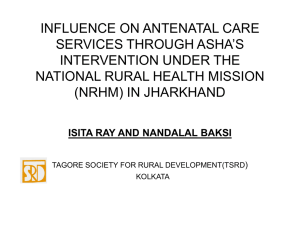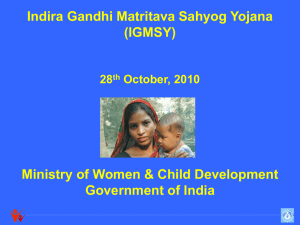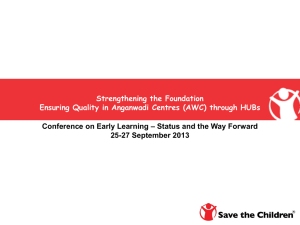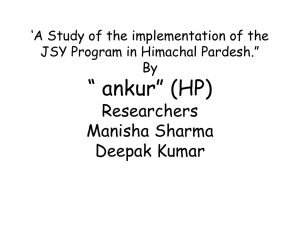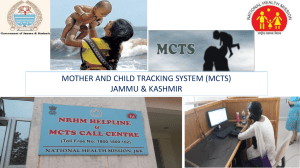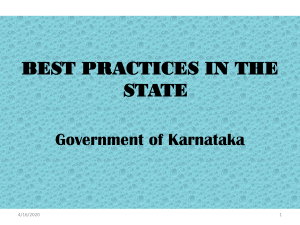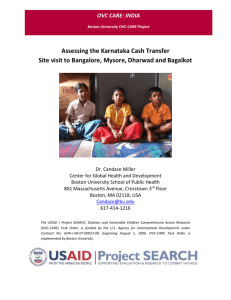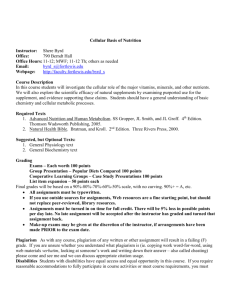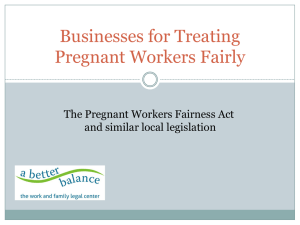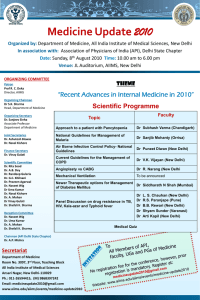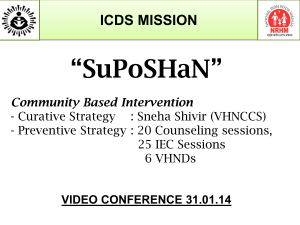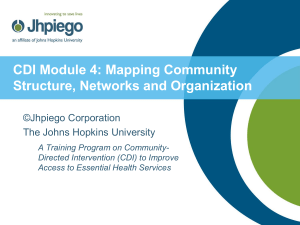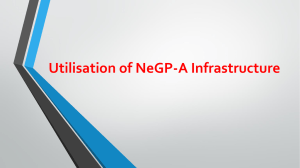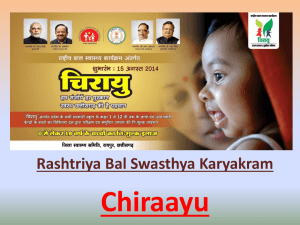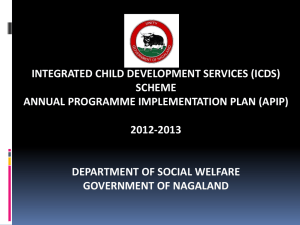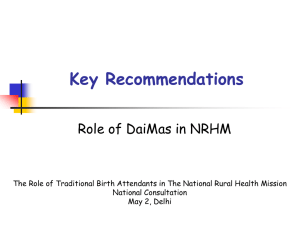3 convergence
advertisement
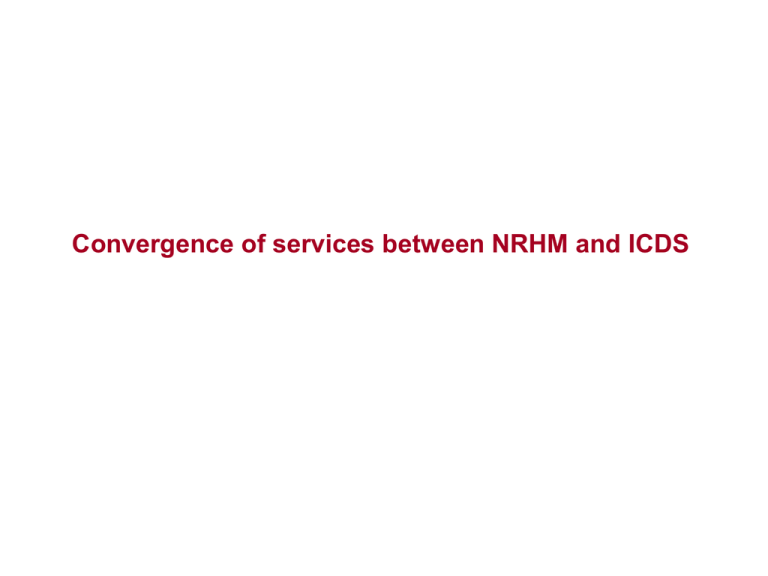
Convergence of services between NRHM and ICDS Convergence of services Nutrition NACP NVBDCP NCCP PEOPLE SHP IDD NBCP PFA& D Education IDSP RNTCP CURRENT FUNCTIONING OF ANGANWADIS Figur e 9.6: P er cent age of childr en age 0- 71 mont hs r ecieving ser vices f r om an AWC 100 Not receiving supplementary food Any services Almost daily receving supplementary food 80 60 40 20 0 <12 12-23 24-35 36-47 48-59 60-71 Source Reference 9.8 During the first 2 years, less that a third of the children received any services and the proportion receiving food supplements were negligible. In the other age groups only one-fifth had received supplementary food. 120 100 Figure 9.7: Percentage of children 0-59 months in areas covered by AWC by frequency of weighing % 80 60 40 20 0 <12 Source Reference 9.8 12-23 24-35 Not at all 36-47 Atleast once a month 48-59 Atleast once in three months Inspite of guidelines specifying that monthly weighing of children should be done in the crucial 024 months age group, the percentage of 0-12 and 1223 months old children who were weighed every month was negligible. Among the 2-6 years old children, less than 10% have been weighed once in three months Figure 9.9: Interstate differences in services received during pregnancy Mizoram Goa Meghalya Himachal Pr. Karnataka Sikkim Andhra Pr. Gujarat Rajasthan Assam Uttar Pr. Punjab J&K Delhi Bihar 0 10 20 Supplementary food NFHS -3 Source: Reference 9.8 30 Health check-ups 40 50 NHE 60 70 There are huge interstate differences in pregnant women accessing AW based services Compared to other states Delhi performs poorly in ICDS based AN services. This might be partly attributable to ready access to ANC in hospitals and relatively low poverty ratio in Delhi Figure 9.10: Percentage of children 0-71 months receiving any services from an AWC Chhatisgarh Madhya Pr. Meghalya TamilNadu Jharkhand Nagaland Karnataka India Kerala Manipur Haryana Uttar Pr. J&K Punjab Bihar 0 Source: Reference 9.8 NFHS 3 10 20 30 40 Percentage 50 60 70 There are large interstate differences inchildren accessing anganwadi services . In Delhi proportion ofchildren accessing anganwadi is low . This might be due to low poverty ratio, ready access to hospitals providing child care and lack of space in anganwadi where children could sit and participate in activities . Coverage under health mission PRIMARY HEALTH CARE & NUTRITION PRIORITIES Detection and correction of undernutrition and anaemia in pregnancy Coping with low birth weight neonate Reduction of IMR, high morbidity and undernutrition during infancy Reduction of under five mortality rates& high undernutrition rates in preschool children Reduction in anaemia in Indians Ensuring universal access to iodised salt by 2010 Ante natal/intrapartum care Current status ANC coverage is low; content is suboptimal. Majority do not get weighed; detection of undernourished pregnant women and targeted food supplementation and health care for those with undernutrition not operationalised Very few get Hb estimation done; appropriate management of anaemia is non existent; consumption fo IFA tablets low Majority go to hospital for delivery but care in home deliveries is poor What can convergence between ICDS and Health Mission can achieve ? Essential antenatal care for all pregnant women can be provided during the village health and nutrition days AWW, AW helper and ASHA can inform women so that they reach a common place where ANMs can examine them and give appropriate advice, IFA tablets , TT injections and also refer those with problems. Most of Delhi anganwadi’s do not have enough space where pregnant women can be brought together for examination and advice However near most anganwadis there are community halls, dharmshalas.By approaching appropriate authorities, it might be possible to get the health and nutrition day as well as immunisation day organised in these buildings. As all pregnant women are collected in one place,group counseling will be possible. ANM can examine all women and get the forms completed with the help of the AWW, give TT injections and IFA tablets. Under weight women can be identified and AWW worker can try to provide food supplements on priority to them. Women requiring referral can be identified and ASHA can help them in reaching hospitals for care. Synergy in delivery care Decision regarding place of delivery (domiciliary & health facilities). ANM will identify low risk women who can deliver at home; AWW and ASHA can monitor for clean delivery ;if there are complications during delivery ASHA can help the woman to access emergency care at the right place. All Anganwadis should have information on nearest hospital where pregnant women could be referred In home deliveries AWW can weigh all neonates ( in Delhi perhaps 5 / year in an anganwadi) , identify those weighing less than 2 kg and refer them to nearest hospital for care; AWW should have the nearest hospital where neontes can be referred; ASHA may facilitate referral This will help in reducing the neonatal mortality in home deliveries What can an AWW do to reduce IMR Weigh home born babies soon after birth; refer those who weigh less than 2.2 kg Ensure early initiation of breast feeding Ensure exclusive breast feeding for first six months Collect infants in AWC on immunisation days so that infants get immunised on schedule by the ANM Provide nutrition education and enable the mother to give adequate quantities of appropriate complementary feeds from home food Advise regarding feeding during illness and convalescence Act as depot holder for ORT, Immunisation days can be utilised for providing immunisation and for advice regarding infant feeding and caring practices and contraceptive care Immunisation rates can go up rapidly if there is good coordination between the AWW and the ANM During immunisation days the AWW and ASHA can collect the children and pregnant women ANM can immunise them in the anganwadi, advice mothers regarding appropriate infant feeding and caring practices and provide contraception related counseling Convergence of services AWW can weigh neonates in home deliveries and refer those requiring care advise regarding exclusive breast feeding and complementary feeding identify undernourished pre-school children by weighing them at least once every three months and give food on priority to them; act as depot holder for ORS. assist in emergency referral Convergence of services ANM will Immunize all infants, pregnant women and children as per schedule. Screen children – especially the under nourished ones for health problems and manage/ refer those with problems. AWW will Assist ANM in organizing immunization health check ups in anganwadi; Assist ANM in administering massive dose Vitamin A
